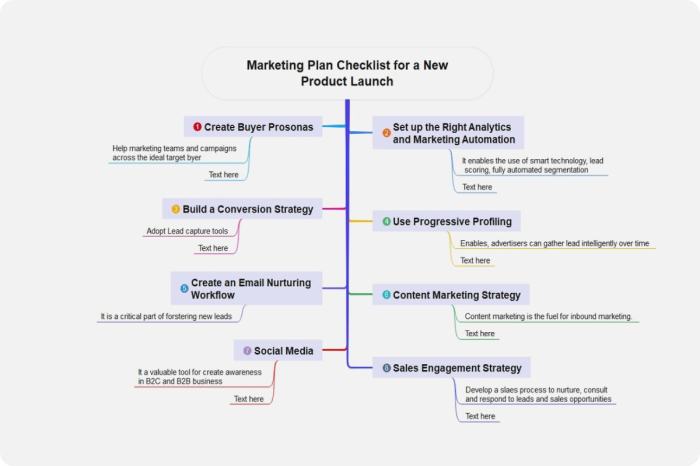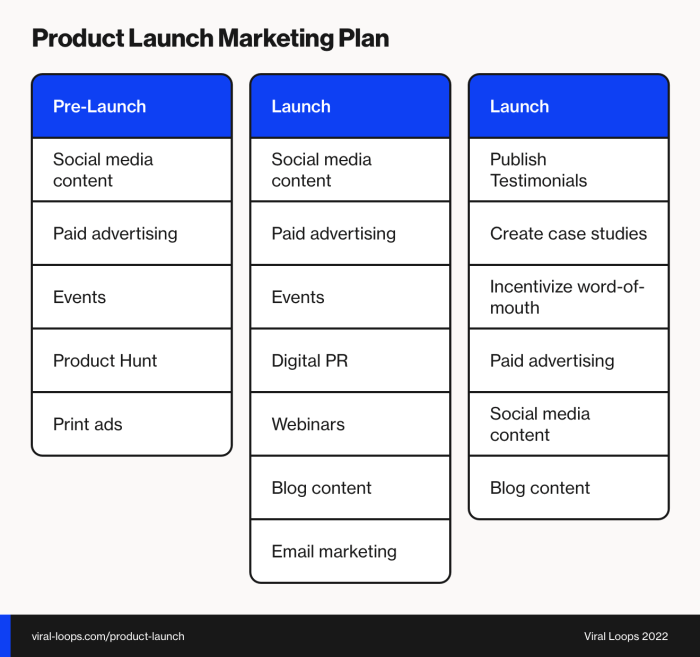Developing a Product Launch Plan sets the stage for a winning strategy, inviting readers into a world of creativity and precision. Get ready to dive into the essential elements of a successful product launch plan.
From market research to budgeting and promotion strategies, this guide covers everything you need to know to ensure a seamless and impactful product launch.
Overview of Product Launch Plan
Having a detailed product launch plan is crucial for the success of a new product in the market. It helps in ensuring that the product is introduced effectively and efficiently to the target audience, maximizing its impact and potential for success.
Key Components of a Product Launch Plan
- Market Research: Understanding the target audience, competition, and market trends is essential for tailoring the product launch strategy.
- Goals and Objectives: Clearly defining the goals and objectives of the product launch helps in setting measurable targets for success.
- Messaging and Positioning: Developing a compelling message and positioning the product effectively in the market is crucial for capturing the attention of consumers.
- Marketing and Promotions: Planning the marketing activities, advertising campaigns, and promotional strategies to create buzz around the product launch.
- Sales Strategy: Outlining the sales approach, distribution channels, and pricing strategy to drive sales post-launch.
- Timeline and Budget: Establishing a detailed timeline and budget for the product launch to ensure that everything stays on track and within financial constraints.
Benefits of a Well-Thought-Out Product Launch Plan
- Increased Visibility: A well-planned product launch can generate buzz and interest, increasing visibility and awareness of the product.
- Higher Sales Potential: By reaching the target audience effectively and creating demand, a well-thought-out plan can lead to higher sales potential.
- Enhanced Brand Reputation: A successful product launch can enhance the brand’s reputation and credibility in the market, leading to long-term benefits.
Market Research and Analysis
Market research plays a crucial role in developing a product launch plan as it helps companies gather insights into the target market, competition, and consumer behavior. By conducting thorough market research, businesses can make informed decisions and create effective strategies for a successful product launch.
Role of Market Research
- Identifying target market segments and their needs
- Evaluating the competitive landscape
- Assessing consumer preferences and trends
- Determining pricing strategies
Market Analysis for Understanding Consumer Needs
Market analysis is essential for understanding consumer needs and preferences as it provides valuable data on market trends, buying patterns, and customer demographics. By analyzing market data, businesses can tailor their product offerings to meet consumer demands and stay ahead of competitors.
Methods for Conducting Market Research
- Surveys and questionnaires to gather feedback from target customers
- Focus groups to understand consumer perceptions and preferences
- Competitor analysis to identify strengths and weaknesses in the market
- Data analytics to track consumer behavior and trends
Target Audience Identification: Developing A Product Launch Plan
Identifying the target audience is crucial for a successful product launch. By understanding who your customers are, you can tailor your marketing strategies to effectively reach and engage with them.
Demographic Factors
- Age: Consider the age range of your target audience to determine their preferences and buying behaviors.
- Gender: Understand the gender demographics to create targeted messaging that resonates with your audience.
- Income Level: Identify the income bracket of your target audience to price your product accordingly.
- Location: Know where your audience is located to customize distribution channels and marketing campaigns.
Psychographic Factors
- Lifestyle: Analyze the interests, values, and lifestyle choices of your target audience to create relevant marketing content.
- Personality Traits: Consider personality traits such as introversion or extroversion to tailor your messaging appropriately.
- Values: Understand the core values and beliefs of your audience to align your product with their principles.
Behavioral Factors
- Buying Patterns: Study the purchasing behavior of your target audience to anticipate their needs and preferences.
- Brand Loyalty: Determine the level of brand loyalty among your audience to develop customer retention strategies.
- Usage Frequency: Identify how often your audience uses similar products to position your offering effectively.
Product-Target Audience Alignment
To ensure the success of your product launch, it is essential to align the product features with the identified target audience. By understanding their demographics, psychographics, and behaviors, you can tailor your product to meet their specific needs and preferences. This alignment will not only increase the chances of a successful launch but also foster customer loyalty and satisfaction.
Setting Clear Objectives

Setting clear objectives for a product launch plan is crucial as it provides a roadmap for the team to follow and ensures everyone is aligned towards the same goals. Without clear objectives, it’s easy for the launch to veer off track, leading to wasted resources and missed opportunities.
Importance of SMART Goals
Utilizing SMART goals is a great way to establish measurable objectives for a product launch plan. SMART stands for Specific, Measurable, Achievable, Relevant, and Time-bound. By setting goals that meet these criteria, teams can track progress, stay focused, and know when they have achieved success.
- Specific: Clearly define what needs to be accomplished.
- Measurable: Establish concrete criteria for measuring progress.
- Achievable: Set realistic goals that are within reach.
- Relevant: Ensure that the objectives align with the overall goals of the product launch.
- Time-bound: Set deadlines to create a sense of urgency and accountability.
Examples of Objectives
When setting objectives for a product launch plan, it’s essential to be specific and actionable. Here are some examples of specific objectives that can be set:
- Increase brand awareness by X% within the first quarter after launch.
- Generate X number of leads through the product launch campaign.
- Achieve X% conversion rate from leads to customers within the first month.
- Secure X number of media placements in top industry publications.
Budgeting and Resource Allocation
When it comes to launching a new product, budgeting and resource allocation play a crucial role in ensuring the success of the launch plan. Proper budgeting helps in determining how much money is needed for each aspect of the launch, while effective resource allocation ensures that the available resources are utilized efficiently.
Importance of Budgeting and Resource Allocation, Developing a Product Launch Plan
Proper budgeting allows you to allocate funds strategically, focusing on key areas that will have the most impact on the success of the product launch. It helps in avoiding overspending and ensures that resources are used wisely throughout the launch process.
- Identify key areas that require funding, such as marketing, product development, and distribution.
- Allocate resources based on the priorities of the launch plan, focusing on activities that will drive the most value.
- Regularly monitor and adjust the budget as needed to stay on track and make the most of the available resources.
Optimizing the Budget for Maximum Impact
Optimizing the budget for a product launch involves finding ways to maximize the impact of the allocated resources, ensuring that every dollar spent contributes to the success of the launch. Here are some tips to help you get the most out of your budget:
- Focus on targeted marketing efforts to reach your specific audience effectively.
- Invest in high-quality product development to create a product that meets the needs and expectations of your target market.
- Explore cost-effective distribution channels to ensure that your product reaches consumers efficiently.
- Consider partnerships or collaborations that can help extend your reach and minimize costs.
Marketing and Promotion Strategies

In today’s competitive market, having effective marketing and promotion strategies is crucial for the success of a product launch. These strategies help in creating awareness, generating interest, and ultimately driving sales for the new product.
Utilizing Multiple Channels for Promoting the Product
To maximize the reach and impact of a product launch, it is essential to utilize multiple channels for promoting the product. This can include a combination of digital marketing, social media campaigns, influencer partnerships, email marketing, traditional advertising, and PR efforts. By diversifying the marketing channels, you can target different audience segments and increase the chances of reaching potential customers.
- Implementing a comprehensive digital marketing strategy that includes social media advertising, search engine optimization (), and content marketing can help increase online visibility and engagement.
- Collaborating with influencers or brand ambassadors who have a strong following can help in reaching a wider audience and building credibility for the new product.
- Utilizing email marketing campaigns to nurture leads and keep customers informed about the product launch can drive conversion and retention.
- Combining traditional advertising methods such as print ads, TV commercials, and radio spots with digital efforts can create a cohesive and impactful marketing campaign.
- Engaging in PR activities such as press releases, media interviews, and product reviews can help in gaining media coverage and building buzz around the product launch.
By leveraging multiple channels for promotion, you can create a holistic marketing approach that reaches a diverse audience and maximizes the impact of the product launch.
Successful Marketing Campaign Examples
There have been several successful marketing campaigns in the past that have significantly boosted product launches. One notable example is Apple’s launch of the iPhone, which utilized a combination of sleek product design, innovative features, and strategic marketing tactics to create hype and anticipation among consumers. Another example is Coca-Cola’s “Share a Coke” campaign, where personalized bottles with names and messages resonated with customers and led to increased sales and brand engagement.
- The “Dove Real Beauty Sketches” campaign by Dove, which focused on promoting self-confidence and empowerment, went viral and garnered millions of views, boosting brand perception and sales.
- The “Old Spice Man” campaign, featuring humorous and engaging commercials, revitalized the brand and led to a significant increase in sales and brand awareness.
- The “Red Bull Stratos” campaign, where Felix Baumgartner skydived from the edge of space, generated massive buzz and positioned Red Bull as a daring and adventurous brand, resulting in a spike in sales and brand loyalty.
Timeline and Milestones
Creating a timeline with milestones is crucial for tracking progress during a product launch. It helps in staying organized, identifying key deadlines, and ensuring that the launch stays on track.
Setting Specific Milestones
Setting specific milestones allows you to break down the product launch process into manageable tasks. By having clear milestones, you can easily track progress, identify any potential issues early on, and make necessary adjustments to your strategies.
- Define key milestones such as product development completion, marketing campaign launch, media outreach, etc.
- Assign realistic timelines to each milestone to ensure they are achievable.
- Regularly review and update the milestones as needed to adapt to any changes in the plan.
Managing the Timeline Effectively
Managing the timeline effectively is essential for a successful product launch. Here are some tips to help you stay on track:
- Use project management tools to create and monitor the timeline.
- Set reminders and deadlines for each milestone to keep the team accountable.
- Regularly communicate with team members to ensure everyone is aware of their responsibilities and timelines.
- Identify potential bottlenecks or delays early on and take proactive measures to address them.
